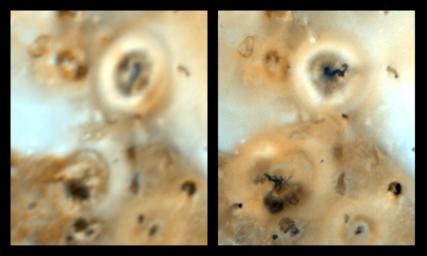
|
Changing volcanoes on Io
- Click the image above for a larger view
- Full-Res JPEG (1215 x 729) (60.5 kB)
- Full-Res TIFF (1215 x 729) (2.4 MB)
Caption:
Volcanoes on Jupiter's moon Io are compared in these images from NASA's Galileo spacecraft (right) taken in early September of this year, and from the Voyager spacecraft (left) taken in 1979. Prometheus (bright ring in upper right) was first seen as an erupting volcano by the Voyager spacecraft and still features an active plume. A smaller active plume was discovered at the volcano Culann Patera (dark feature at lower left) by the Galileo spacecraft.
Prometheus has displayed similar characteristics such as size, shape and brightness to Galileo's cameras as it did to Voyager's. However, several intriguing differences are also apparent. There appears to be a new dark lava flow emanating from the vent of Prometheus, and the plume is now erupting from a position about 75 kilometers (46.5 miles) west from where the hot spot resided in 1979. It is not known if the plume source is the same or if the plume is now emanating from a new source. Overall, scientists studying Galileo images of Io see that a wide variety of surface changes have occurred on Io since 1979. The Galileo image was taken at a range of about 487,000 kilometers (about 302,000 miles) from Io. The Voyager image was taken from about 800,000 kilometers (about 500,000 miles).
Background Info:
The Jet Propulsion Laboratory, Pasadena, CA, manages the mission for NASA's Office of Space Science, Washington, DC. This image and other images and data received from Galileo are posted on the Galileo mission home page on the World Wide Web at http://galileo.jpl.nasa.gov. Background information and educational context for the images can be found at http:// www.jpl.nasa.gov/galileo/sepo
Cataloging Keywords:
| Name | Value | Additional Values |
|---|---|---|
| Target | Io | |
| System | Jupiter | |
| Target Type | Satellite | |
| Mission | Galileo | Voyager |
| Instrument Host | Galileo Orbiter | |
| Host Type | Orbiter | Flyby Spacecraft |
| Instrument | Solid-State Imaging (SSI) | |
| Detector | ||
| Extra Keywords | Color, Plume, Volcano | |
| Acquisition Date | ||
| Release Date | 1997-11-18 | |
| Date in Caption | ||
| Image Credit | NASA/JPL/Ames Research Center | |
| Source | photojournal.jpl.nasa.gov/catalog/PIA00495 | |
| Identifier | PIA00495 | |
